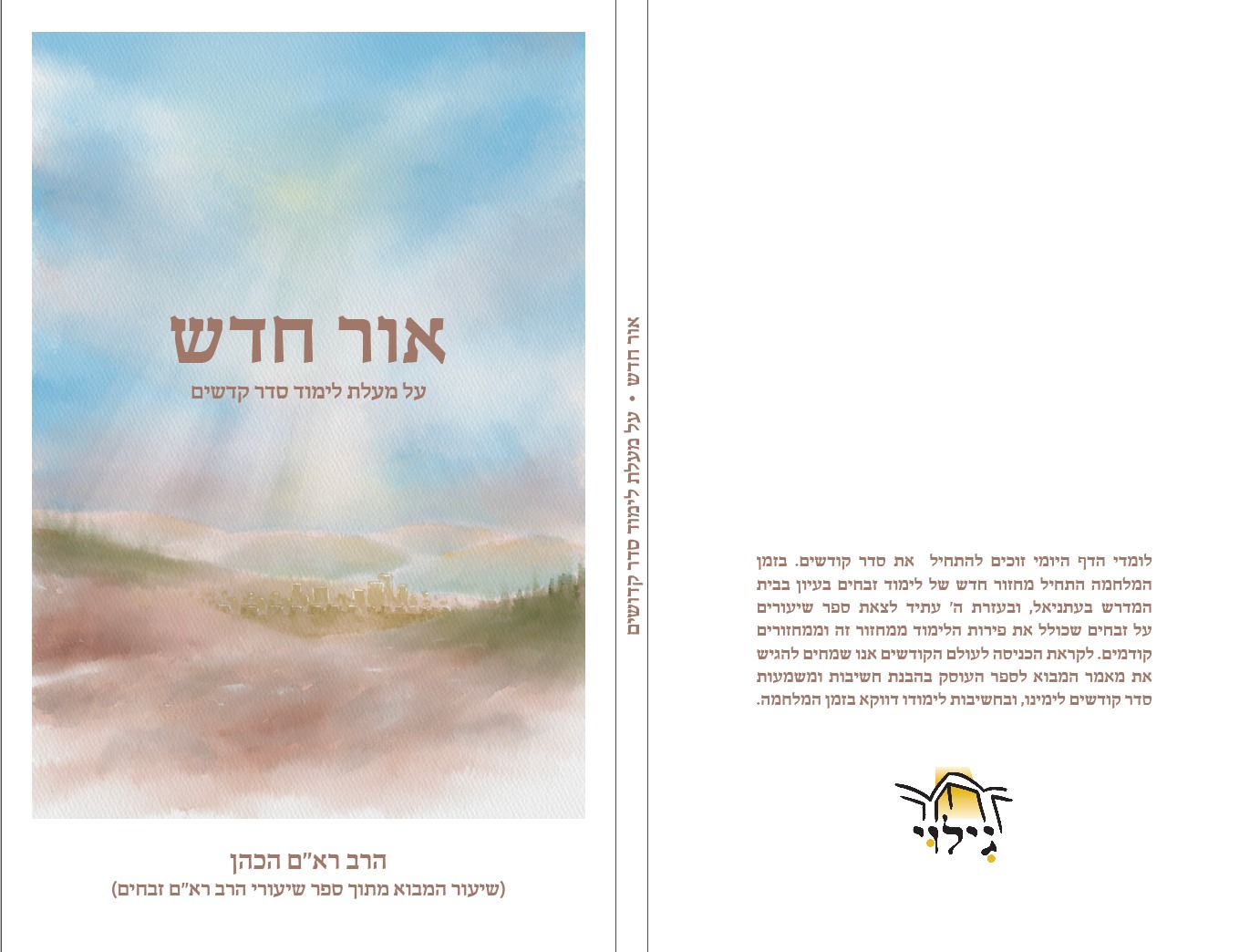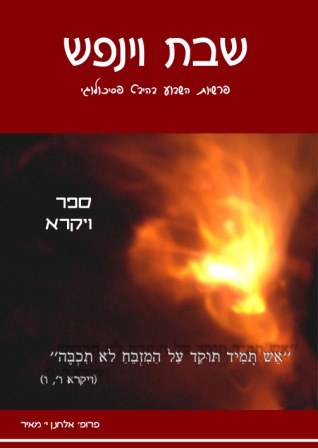נושאים
Translated by Netzach Sapir
The Talmud tells a story of a man who once heard of a famous prostitute in a far away land. His desire overcame him, and he traveled to see her. The story develops in a not altogether surprising manner; at the last minute the man holds himself back from sinning, thanks to his careful observance of the mitzvah of tzitzit. But the story continues to an unexpected ending, which teaches us about the nature of human inclinations and the way Judaism relates to them. In the words of the gemara:
Once there was a man who was very careful in his observance of the mitzvah of tzitzit. He heard there was a prostitute in a distant town who accepted four hundred gold pieces for her services. He sent her four hundred gold pieces and made an appointment. When the appointed time came, he went and sat at her door… “Enter,” she said, and he entered. She made him seven beds, six of silver and the seventh of gold, with a silver ladder between each bed, and to the top one, a golden ladder. She went up and sat naked on the uppermost bed, and he ascended to sit naked beside her. Suddenly the four fringes of his tzitzit brushed against his face and he slipped down and sat on the ground. She slipped down after him and sat beside him.
“By the Roman emperor,” she demanded, “I won’t let you leave until you tell me what blemish you saw in me!”
“By the service of G-d,” he replied, “never have I seen a woman as beautiful as you. But there is one mitzvah that G-d has commanded us called tzitzit, and regarding it, twice it is written ‘I am Hashem your G-d’ (Bamidbar 15:41), I am the G-d who will punish and the G-d who will reward, and [the four fringes of my tzitzit] will be as four witnesses against me.”
She said to him: “I won’t let you go until you tell me your name, the name of your city, the name of your Rabbi, and the name of the Beit Midrash where you study Torah.” He wrote it down and put it in her hand.
She then divided all her possessions – a third she gave to the kingdom, a third to the poor, and a third she kept for herself – except for her beds and bedding, and came to the Beit Midrash of Rabbi Chiya.
She said to him, “Rabbi, instruct me and I shall be a convert.”
He questioned her, “My daughter, might you have laid eyes on one of my students?” She showed him the note in her hand.
He said to her, “Go and enjoy your claim.”
The same beds which she had spread for him illicitly she now spread for him permissibly. (Menachot 42a)
At the end of the story the prostitute comes to the Beit Midrash of her not-quite-client and approaches his Rabbi, Rabbi Chiya, with the request to convert. Her request is greeted with suspicion and reservations about the purity of her motives. Indeed, Rabbi Chiya’s suspicion that she has “laid eyes on one of [his] students” is correct, but when he sees the note in her hand, he changes his mind and accepts her.
Though the gemara tells the story to demonstrate the power of tzitzit in changing a man’s heart, the prostitute also undergoes a process of growth in the story. As a matter of fact, she undergoes a much more dramatic and meaningful change than he does. When her visitor has a sudden change of heart, she initially fears that he has found her to be repugnant. He seeks to reassure her, telling her that his change of heart has nothing to do with her appearance, that actually, he has never seen a woman so beautiful. But his answer doesn’t leave her at rest. After witnessing his impressive behavior, his willingness to give up the object of his desire in which he had already greatly invested and instead respond to a higher call, the prostitute realizes that though she has no external blemish, something inside is missing, her way of life is not whole. So she makes a radical decision, abandons her lifestyle and wealth, and follows in the footsteps of the one who granted her this insight, eventually meriting to “enjoy her claim.”
Fringed Garments and Gilded Beds
The most interesting aspect of the story is the way the prostitute relates to the tools of her trade – her beds and her ladders. One would think that on her way to a new life, she would quickly seek to distance herself from those things most intimately associated with the life she seeks to leave behind, namely, her beds, but she departs on her journey with the entire assemblage in tow. She isn’t the only one who sees them as important; the gemara itself makes a point of noting that after her conversion, she offers to her husband the same beds she had used in her trade. The key to the moral of this unusual story lies, in my opinion, in her beds.
First of all, there is a significance to the number of beds (seven) and the number of ladders (six). These numbers parallel the wrappings of the tzitzit. The strings of the tzitzit are wrapped in thirteen bands – seven bands of blue techelet, symbolizing the seven heavens, and six bands of white string, symbolizing the atmosphere between them (Menachot 39a). The top most bed is made of gold, and it corresponds to the last band of the tzitzit, which, according to the gemara, is the holiest one (ibid).
One would think that this parallelism comes to make a contrast, a sort of “this as opposed to this, made the Lord” (Kohelet 7:14). The movement toward holiness is expressed by the upper band of the tzitzit which represents the seventh heaven, whereas the prostitute’s seventh bed represents the approach toward sin and impurity. It is surprising, then, that ultimately the beds receive such positive treatment in the gemara. To help understand the story’s message, let us turn to the torah of the Baal Shem Tov. The Baal Shem Tov teaches that there are three levels in the spiritual rectification of one’s inclination to do wrong: subduing, separation and sweetening. These three levels appear in our story. First, in the simplest sense, the urge itself is subdued. Ascending to the naked prostitute whom he has hired, the man manages to overcome his desire and withhold himself from sin. In the second step, separation, the man leaves her and returns to his town and his Beit Midrash, but before he does so, he writes her a note, “he wrote it down and put it in her hand.” The language of the gemara here is reminiscent of the language of the torah regarding divorce, “and he must write her a bill of separation and put it in her hand” (Devarim 24:1).
In the third step, the sweetening, the would-be sinners marry, and “the same beds which she had spread for him illicitly she now spread for him permissibly.” The inclinations have come to expression in a place of holiness, in marriage. The story teaches us that human urges and inclinations are not inherently wrong or evil, but when they hold the reins, they are liable to lead to negative places. The goal is not to uproot and destroy one’s inclination, but to channel it toward expression in the proper contexts. This is what the Baal Shem Tov means when he speaks of the sweetening of the inclination. The connection between the word for inclination, “yetzer,” and the word “yetzira,” creation, bears witness to the potential for good in Man’s inclinations.
The complexity of the Torah’s attitude toward human inclinations can also be seen in the way Rabbi Chiya responds to the prostitute when she asks to convert. Before he agrees, he asks suspiciously, “might you have laid eyes on one of my students?” As far as he is concerned, the desire to convert in order to marry someone is not a legitimate basis for a conversion. And indeed, his suspicions are proved true; the prostitute had laid eyes on one of his students. Nonetheless, in the end he accepts her and gives his blessing to the couple. The desire to marry, in and of itself, is not a problematic motive for wishing to convert. The question is, what stands behind that desire? When the Rabbi understood that the woman’s desire to marry one of his students came from a deep place, and that her attachment to him was for his internal world, that it even brought her into Judaism’s embrace, he blessed their bond.
And You Shall Be Holy
It is not a coincidence that the tzitzit instigate the turning point in the story. The process of growth that the story’s protagonists undergo parallels the structure of the command of tzitzit.
Speak to the children of Israel and instruct them to make for themselves tzitzit on the corners of their garments, for all generations, and on the corner tzitzit, they should attach a strand of techelet. This will be your tzitzit, and when you see it you will remember all of the mitzvot of G-d, and you shall do them, and not follow after your hearts and your eyes which lead you astray. This way you shall remember, and do all of My mitzvot, and you shall be holy to your G-d. I am Hashem your G-d, who took you out of Egypt in order to be your G-d, I am Hashem your G-d. (Bamidbar 15:38-41)
The passage reads “remember all of the mitzvot of G-d, and shall do them,” and then, in the following verse, we are again told “you shall remember and do all of My mitzvot.” Why the repetition?
The seeming redundancy comes to teach us that actually, there are two different stages being addressed here. The first is “turn away from evil” (Psalms 34:15), the instruction to overcome our evil inclination, “and you shall not follow after your hearts and your eyes which lead you astray.” After the first stage, the turning away from the negative, comes the second stage, “and do good” (ibid), the movement toward the positive, “and you shall be holy to your G-d.” If we return to our story, we see the correspondence. Initially, the tzitzit are that which cause the man to withhold himself from sinning, to not stray after his eyes and his heart. The story ends, though, with the second stage, “and you shall be holy,” when the couple enter a covenant of marriage, “behold you are holy.[1]”
The structure of our parsha comes to teach us that in the journey towards holiness, towards G-d, a person must be constantly engaged in working on himself and mastering self-control. Only upon residing in a place of purity can one connect to true holiness. When a person is lacking this internal purity, his spiritual journey is liable to bring him to perversion and he is in danger of crossing the fine line between avodat Hashem, the service of G-d, and avoda zara, the service of false gods and vanity. In the language of Rav Kook, “morality is the corridor, and holiness is the palace” (Shemona Kevatzim, 1:133). Morality is concerned primarily with the world of “turn away from evil,” it creates boundaries and guides man to overcome his negative qualities. Avoiding evil alone does not equal holiness, but it is the first step on the journey towards it.
In his book “Mei HaShiloach” (part 2, Parshat Shelach), Rabbi Mordechai Leiner of Ishbitz offers another interpretation. In the first stage of the command of tzitzit, the mitzvot are described in third person, in concealed form, “all of the mitzvot of G-d,” whereas in the second stage, they appear in first person, in the imminent form, “all of My mitzvot.” The first stage, the awe and fear, is symbolized by the techelet, and because of the attendant fear, appears in its concealed form. But the second stage, which is represented by the white strings of the tzitzit, is that of love and connection, so the language of the text is imminent.
The command of tzitzit concludes with the verse, “I am Hashem your G-d, who took you out of Egypt in order to be your G-d.” We escaped Egypt and physical slavery long ago, but the spiritual work that the Torah offers us enables us to escape from a far more insidious and painful subjugation, the slavery of within, the slavery to our evil inclination and negative qualities. Only when we manage to escape from that slavery will we truly be free.
All Are Holy?
The verses pertaining to tzitzit teach us how to be holy. Many people have pointed out the similarity between the tzitzit and the priestly garments; both include a strand of blue techelet, both are comprised of a mixture of wool and linen – a combination prohibited in any other garment. The message seems to be the same as that which we saw in parshat Yitro, “and you shall be unto me a kingdom of priests and a holy nation” (Shmot 19:6). This seems justify the claim which immediately follows the mitzvah of tzitzit, Korach’s allegation against Moshe and Aaron, “Everybody in the entire assembly is holy, and G-d among them. Why do you put yourselves above the congregation of G-d?” (Bamidbar 16:3). But Korach failed to understand that holiness can only be achieved through action, and that Am Yisrael’s unique standing is not a matter of race but a function of their behavior. We would be misled to read “and you shall be unto me a kingdom of priests and a holy nation” as separate from the verse that precedes it, “and now if you listen to my voice, and guard my covenant, you will be a treasure unto me among all the nations.”
Many people are drawn toward spirituality and seek to connect to holiness, but fewer are those who are ready to commit to meaningful, life-changing action to that end, without which spiritual growth is impossible.
We learn from what is said of tzitzit that our experience is dependent on our actions, ‘being’ follows from ‘doing.’ “This way you shall remember, and do all of my mitzvot, and you shall be holy to your G-d.” First we must ‘do,’ then we will ‘be.’ Man’s actions don’t only influence that which is around him, they also shape his own identity. It is interesting to note that G-d ascribes to Himself these two stages as well. ‘Doing’ comes first, “I am Hashem your G-d, who took you out of Egypt,” and is followed by ‘being,’ “in order to be your G-d, I am Hashem your G-d.”



























